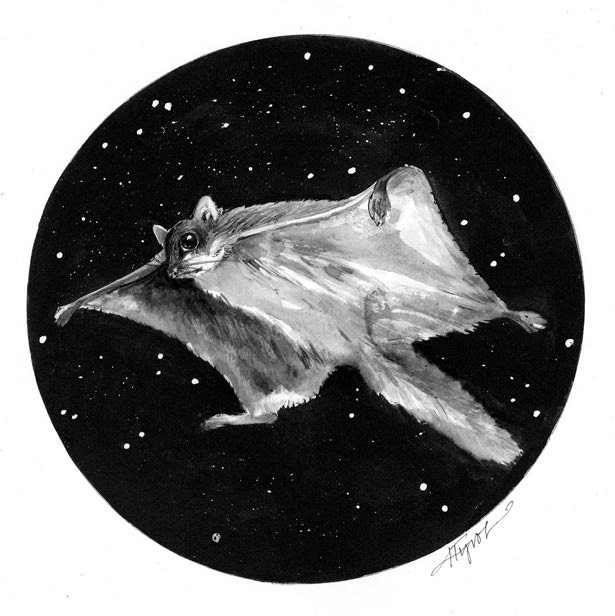
Some time ago our neighbor called me over at dusk to observe a flying squirrel eating seed at his bird feeder. I had never encountered this animal and was most intrigued. Afterwards I said to myself, “I wish we had a flying squirrel.”
Well, sometimes you get what you wish for. The attic of our house is ventilated at each end by screened openings protected from the weather by wooden louvers. On one of our infrequent trips to the attic we noticed an untidy mass of leaves stuffed between the screen and the louver. As we investigated, the leaves began to stir. Out popped the most adorable little animal, with soft gray fur and enormous dark eyes. It surveyed us anxiously for a few moments, then slipped through the louver and launched into mid-air. Flattened, like a furry kite with tail outstretched, it glided in a downward arc to a nearby tree trunk and scurried from sight. Again the leaves rustled, and one by one, four nest mates emerged and repeated the graceful aerial voyage. We had not just one flying squirrel but a small colony.
While few people have seen this secretive nocturnal creature, flying squirrels are in fact common in the forested Northeast. In Vermont and New Hampshire, two species of flying squirrel overlap ranges. The northern flying squirrel, rich brown and bigger (to 14 inches long, nose to tip of tail), ranges down from Canada, while the southern flying squirrel, paler and smaller (to 10 inches long), is found just south of the Canadian border all the way to Florida. Surprisingly, the diminutive southern species is more aggressive and is known to drive off its northern relative.
A more appropriate name for his creature might be ‘gliding squirrel,’ since these animals do not truly fly. A large flap of skin, called the patagium, extends from the animal’s flanks and attaches all the way to wrist and ankle. To glide, the squirrel leaps out and spread-eagles itself, pulling the patagium taut. Buoyed on this aerofoil, it floats outward and downward, in ideal conditions sailing three feet for every one-foot drop. A squirrel launched from 100 feet up could glide the length of a football field.
The patagium is not just a passive membrane, rather it consists of various muscles, including one along its border that tightens or slackens to assist steering. A special cartilage strut hinges out from the foreleg to stiffen the patagium’s leading edge. Gliding squirrels are highly maneuverable and can weave between trees and branches. The squirrel’s tail, much like the tail of a kite, acts as a stabilizer, important for balance. On the approach to its landing on a tree trunk the squirrel draws in its forelegs, and the patagium folds to become a parachute for the touchdown, hind feet first. Upon landing, the squirrel often hurries to the opposite side of the trunk in case a predator is following. As an additional safeguard, the squirrel’s brittle tail breaks off if grabbed.
The hauntingly large eyes of flying squirrels help them to see and fly by night, which means they don’t have to worry about daytime predators. Their eyes are on the sides of the head, producing a wide visual field for predator spotting, but not much three-dimensional vision, as this requires forward-facing eyes with visual field overlap. Thus, before gliding on a new route the squirrel bobs its head about, taking several different views to gauge the distance to the landing spot by triangulation. Once a route is learned however, they no longer triangulate. In fact they barely look. Squirrels have been known to crash-land repeatedly when a tree on which they had habitually landed has been cut down.
Gliding in the dark can be hazardous, so flying squirrels sport the longest whiskers of any squirrel to help detect twigs and other obstacles. Additional whiskers around the eyes may function to warn of an impending poke in the eye. The squirrels also protect their eyes by momentarily shutting them while they land, a behavior revealed through examination of video footage.
If you live around large areas of mixed woods with mature oaks, beeches and large dead trees, you could be amongst flying squirrels. These animals subsist primarily on nuts and acorns, but they also consume fruit, berries, fungi, plant buds and flowers. Despite their cuddly appearance, southern flying squirrels have the dubious honor of being the most carnivorous of our squirrel species. They spice up their vegetarian diet with bird eggs and nestlings, carrion, shrews and mice (as do all squirrels but in smaller amounts.)
Flying squirrels like to live in the cavities in dead trees, in woodpecker holes or in the cozy space of someone’s attic. Tracks on the snowy roof beneath our attic louver remind me that these creatures don’t hibernate and will be out gliding whenever winter nights are mild.

